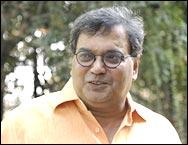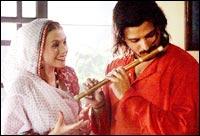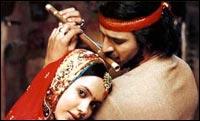|
|
| Help | |
| You are here: Rediff Home » India » Movies » Interviews » Subhash Ghai |
|
| |||||||||||||||||||||||
|
| |||||||||||||||||||||||
 Subhash Ghai's Kisna is fascinating also because of a strikingly different cast. He has gone with critically praised but box-office cub Vivek Oberoi [Images], and two new actresses -- one an English girl having to speak Hindi, and the other, a dancer who has never acted before.
Subhash Ghai's Kisna is fascinating also because of a strikingly different cast. He has gone with critically praised but box-office cub Vivek Oberoi [Images], and two new actresses -- one an English girl having to speak Hindi, and the other, a dancer who has never acted before.
In his first period film, it all seems like a massive risk. In the second part of Raja Sen's exclusive interview with Ghai, he talks about his decisions.
Don't Miss Part I of the Exclusive Interview!
You have an interesting cast in the film, and this is your first time with Vivek Oberoi. How was it working with him?
I wanted a new cast, but Vivek was interesting. I was impressed with him in Company and Saathiya [Images], which were both different, demanding roles. We needed both elements, for Kisna is the warrior poet. He suited the role for the boy from the mountain, we just had to totally redesign his hairstyle, his look.
What about the two women in the film? ![]()
Kisna on rediff.com! ![]()
![]()
![]()
![]()
Meet Subhash Ghai's new heroine!![]()
Ghai: You will relate to Kisna![]()
Special: All about Kisna!![]()
![]()
![]()
I needed an English girl. I went to London [Images] and Los Angeles, and scouted casting directors, agents, went to drama schools. I didn't want stars. I auditioned 200 girls in London and LA, and finally found Antonia Bernaud who had the charm and sensibility that would appeal to Indian audiences as well.
What is that charm and sensitivity? What will appeal to Indian audiences?
Very blue eyes, white, patchy skin: these may not be very charming for the Indian audiences, because we are brown. Antonia's look is appropriate. The question is of the character, the inner strength, and the look. In the movie she wears Indian dresses, and she should look graceful in these as well. And her character, Katherine, is born in India in the 1930s, so she should look like an Indian British.
Has she spoken Hindi in the film?
 Yeah, she learnt Hindi for about four months. She then started speaking the language perfectly. I told her to try and maintain the dialect, and to speak like a British would speak Hindi. She has done all her own dubbing.
Yeah, she learnt Hindi for about four months. She then started speaking the language perfectly. I told her to try and maintain the dialect, and to speak like a British would speak Hindi. She has done all her own dubbing.
What about Isha? She's another new face�
I was in search of a girl to play Luxmi. The character expresses everything through dance, and so I needed a dancer. After a lot of searching, I found Isha and we tried to groom a dancer into an actress. Her role in the film centres more around dances than vocal, dialogue-based scenes. Overall, I think she's acted reasonably well, especially for her first film.
Looking at your older films -- Hero, Kalicharan -- the curve has changed quite entirely.
Had I not changed, you'd have said I make films of a certain type! (Laughs) It's important for a filmmaker to grow. And keep the changing generations in mind. I've been making movies for three decades, and it was important for me to be different. I'd never made a period film before, and it was a different challenge for me.
How did you conceive Kisna?
 It is a very interesting story. I went to London and befriended a few Englishmen. One of them, his grandfather was born in India, and he described how the old photo albums have lots of Indian faces in them. The grandfather used to keep talking about people in India, his colleagues, servants, bosses, etc, praising Indian love, sacrifice, and relationships. The grandson was fascinated by it.
It is a very interesting story. I went to London and befriended a few Englishmen. One of them, his grandfather was born in India, and he described how the old photo albums have lots of Indian faces in them. The grandfather used to keep talking about people in India, his colleagues, servants, bosses, etc, praising Indian love, sacrifice, and relationships. The grandson was fascinated by it. So I realised there must be an entire generation of British people who stayed in India for their entire lives. They were born and bred there. They lived in India. And what would their mindset be like when they left in 1947? Their personal relationships interested me. Life isn't just political, that's only the background. I tried to base my fiction on some facts. I researched to ground my story with some authenticity.
The Conclusion: Part III of the Subhash Ghai interview
|
|
| © 2008 Rediff.com India Limited. All Rights Reserved. Disclaimer | Feedback |